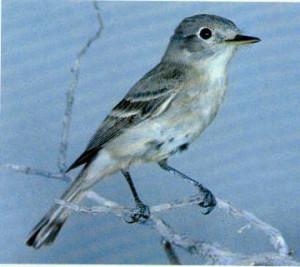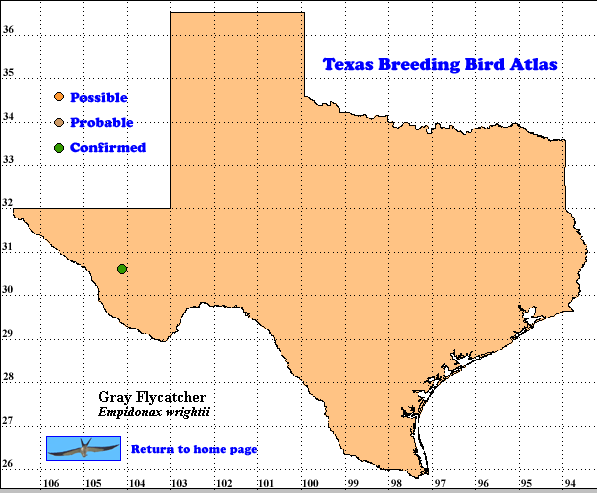The Gray Flycatcher is a gray Empidonax species which breeds though the Great Basin and intermountain west. Visually Gray Flycatcher is one of the easiest of its genus to identify because of its habit of dipping its tail slowly when perched, rather than flicking it up and down as many others of the genus do.
Historically this species and the Dusky Flycatcher (E. oberholseri) were confused. This was clarified after Allan Phillips pointed out that the type specimen of Dusky Flycatcher was actually a Gray Flycatcher and that the two species could be distinguished in the field by differences in the tail movements of perched birds (Sterling 1999).
DISTRIBUTION. The breeding population in the Davis Mountains was first discovered during th TBBA field work (1987-1992). This range expansion may be a part of a general trend for the species as Sterling (1999) noted several other areas of recent range expansion for this species. The Guadalupe Mountains offer another possibility for a new nesting site, although they are much more difficult for observers to access.
Outside Texas Gray Flycatchers breed from the Okanagan Valley of British Columbia south through central Washington and eastern Oregon to southern Idaho and Wyoming , and south through eastern California, Nevada, Utah, and western and central Colorado to the higher elevations of Arizona and New Mexico (Sterling 1999).
In winter Gray Flycatcher is rare and local along the Rio Grande River in Brewster and Presidio counties in Texas, rare in southeast Arizona with most of the population wintering in the highlands of mainland Mexico south to the Isthmus of Tehuantepec and in Baja California Sur (Howell and Webb 1995, Sterling 1999, Lockwood and Freeman 2004).
SEASONAL OCCURRENCE. Gray Flycatchers are uncommon to rare migrants in the western Trans-Pecos from about April 3 to June 8 and from mid-August through early October. Breeding probably occurs from May through mid-August (Oberholser 1974, Lockwood and Freeman 2004).
BREEDING HABITAT. In Colorado, the closest quantitative study, more than 3/4 of Gray Flycatcher nests were in pinyon-juniper woodland with sagebrush a very distant second (Sedgwick 1998).
Gray Flycatcher appears to be very flexible in choosing a plant to support its nest; the choice depends on the habitat and what is available. Popular plants include sagebrush (Artemesia sp), juniper and ponderosa pine. Placement of the nest varies with supporting plant chosen. The female usually builds the nest in as little as 3 days. The nest is built of bark strips, grasses and plant stems and lined with animal hair and feathers.The dimensions vary considerably with materials used.
The female lays 3-4 creamy white eggs (indistinguishable from those of Dusky Flycatcher) which she incubates for 14 days. The length of the nestling stage is unknown. Pairs may raise 2 clutches per year (Harrison 1979, Sterling 1999).
STATUS. Lockwood and Freeman (2004) describe Gray Flycatcher as a locally common summer resident in the Davis Mountains of the Trans-Pecos region. The North American Breeding Bird Survey (BBS) does not sample the species in Texas so no relative abundance or population trend data are available for Texas. Data from 133 routes 40 km (25 mi) long across North America produces a statistically significant population trend of 5.8% population growth per year for the period 1966-2004 (Sauer et al. 2005).
This population growth is certainly consistent with the range expansions noted for this species in recent years and suggests birdwatchers should look for other new breeding colonies in the Trans-Pecos region.
Text by Robert C. Tweit (2005)
Literature cited.
Harrison, H. H. 1979. A field guide to western birds’ nests. Houghton Mifflin, Boston, MA.
Howell, S. N. C. and S. Webb. 1995. A guide to the birds of Mexico and northern Central America. Oxford University Press, New York.
Lockwood, M. W. and B. Freeman. 2004. The TOS handbook of Texas birds. Texas A&M University Press, College Station.
Oberholser, H. C. 1974. The bird life of Texas. University of Texas Press, Austin.
Sauer, J. R., J. E. Hines, and J. Fallon. 2005. The North American Breeding Bird Survey, results and analysis 1966-2004. Version 2005.1. USGS Patuxent Wildlife Research Center, Laurel MD (Web site, http://www.mbr-pwrc.usgs.gov/bbs).
Sedgwick, J. A.1998.Gray Flycatcher *Empidonax wrightii). In Colorado breeding bird atlas. (H. E. Kingery,ed.). Colorado Bird Atlas Partnership, Denver
Sterling, J. C. 1999. Gray Flycatcher (Empidonax wrightii). In The birds of North America, No. 458 (A. Poole and F. Gill, eds.). The Birds of North America, Inc., Philadelphia, PA.

